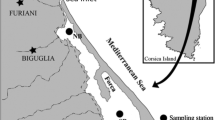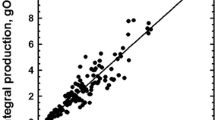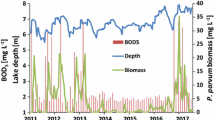Abstract
Photosynthesis and microbial plankton dynamics of two lakes in the Kongsfjorden catchment of Spitzbergen (Svalbard Archipelago, 78°N) were investigated during the summer of 2000. One of the lakes (Tvillingvatnet) served as the water supply for the village of Ny Ålesund. The other was a deeper, larger unnamed lake in the Ossian Sarsfjella reserve—named Lake OS in this study. Both lakes can be classified as oligotrophic on the basis of chlorophyll a and inorganic nutrient concentrations. Chlorophyll a concentrations ranged between 0.33 and 1.65 µg l-1 in Tvillingvatnet and 0.2 and 0.3 µg l-1 in Lake OS. The phytoplankton was dominated by chrysophytes and cryptophytes, with the diatom Rhizosolenia and a number of dinoflagellate species. Rates of photosynthesis were typically low, between 24.5 µg and 1.0 mg l-1 day-1 in Tvillingvatnet (photosynthetic efficiency 0.004–0.26), and between 3.1 and 29.5 µg l-1 day –1 in Lake OS (photosynthetic efficiency 0.0019–0.0085). Among the phytoflagellates (PNAN) there were a number of mixotrophs which reached their peaks of abundance before other PNAN. Mixotrophy appeared to provide a competitive advantage. Grazing rates for the mixotroph Dinobryon ranged between 0.063 and 1.12 pg C cell-1 day-1 in Lake OS and between 0.22 and 1.11 pg cell-1 day-1 in Tvillingvatnet, with rates increasing between July and August. However, Dinobryon removed less than 1% of bacterial biomass day-1, while the heterotrophic nanoflagellates (HNAN) removed up to 28% of bacterial biomass day-1. Bacterial concentrations were low, with a maximum of 28.8×108 l-1 in Tvillingvatnet and 23.6×108 l-1 in Lake OS. Ciliated protozoan and rotifer diversity in the plankton was low.






Similar content being viewed by others
References
Alexander V, Stanley DW, Daley RJ, McKoy CP (1980) Primary producers. In: Hobbie JE (ed) Limnology of tundra ponds, Barrow, Alaska. Dowden Hutchinson and Ross, Stroudsberg, Penn., pp 179–250
Azam F, Fenchel T, Field JG, Gray JS, Meyer-Reil RA, Thingstad F (1983) The ecological role of water column microbes in the sea. Mar Ecol Prog Ser 10:257–263
Bell EM, Laybourn-Parry J (1999) Annual plankton dynamics in an Antarctic saline lake. Freshw Biol 41:507–519
Bird DF, Kalff J (1986) Bacterial grazing by planktonic lake algae. Science 231:493–495
Bloem J, Bär-Gilissen M-J (1989) Bacterial activity and grazing potential in a stratified lake. Limnol Oceanogr 34:297–309
Booij M, Leijnse A, Haldorsen S, Heim M, Rueslåtten H (1998) Subpermafrost groundwater modelling. Nord Hydrol 29:385–396
Bratbak G, Dundas I (1964) Bacterial dry matter content and biomass estimates. Appl Environ Microbiol 48:755–757
Comita GW (1956) A study of a calanoid copepod population in an arctic lake. Ecology 37:576–591
Edmondson WT (1955) The seasonal life history of Daphnia in an arctic lake. Ecology 36:439–455
Ellis-Evans JC, Galchenko V, Laybourn-Parry J, Mylnikov AP, Petz W (2001) Environmental characteristics and microbial plankton activity of freshwater environments at Kongsfjorden, Spitzbeegeb (Svalbard). Arch Hydrobiol 152:609–632
Fuhrman JA (1999) Marine viruses and their biogeochemical and ecological effects. Nature 399:541–548
Gasol JM, Guerrero R, Pedros-Alio C (1992) Spatial and temporal dynamics of a metalimnetic Cryptomonas peak. J Plankton Res 14:1565–1579
Gasol JM, García-Cantizano J, Massana R, Guerrero R, Pedrós-Alió C (1993) Physiological ecology of a metalimnetic Cryptomonas population: relationships to light, sulphide and nutrients. J Plankton Res 15:255–275
Gervais F (1998) Ecology of cryptophytes coexisting near a freshwater chemocline. Freshw Biol 39:61–78
Heath CW (1988) Annual primary productivity of an Antarctic continental lake; phytoplankton and benthic algal mat production strategies. Hydrobiologia 165:77–87
Henshaw T, Laybourn-Parry J (2002) The annual patterns of photosynthesis in two large, freshwater, ultra-oligotrophic Antarctic lakes. Polar Biol 25:744–752
Hobbie JE (1980) Limnology of tundra ponds, Barrow, Alaska. Dowden Hutchinson and Ross, Stroudsburg, Penn.
Hobbie JE (1984) Polar limnology. In: Taub FB (ed) Lakes and rivers. Ecosystems of the world. Elsevier, Amsterdam, pp 63–105
Hobbie JE, Deegan LA, Peterson BJ, Rastetter EB, Shaver GR, Kling GW, O'Brien WJ, Chapin FST, Miller MC, Kipphut GW, Bowden WB, Hershay AE, McDonald ME (1995) Long-term measurement at the Arctic LTER site. In: Powell TM, Steele JH (eds) Ecological time series. Chapman and Hall, New York, pp 391–409
James MR, Hall JA, Laybourn-Parry J (1998) Protozooplankton of the Dry Valley Lakes of Southern Victoria Land. In: Priscu JC (ed) Ecosystem dynamics in a polar desert. Antarct Res Ser 72:225–268
Jones RI, Rees S (1994) Influence of temperature and light on particle ingestion by the freshwater phytoflagellate Dinobryon. Arch Hydrobiol 132:203–211
Kalff J (1967a) Phytoplankton abundance and primary production rates in two arctic ponds. Ecology 48:558–563
Kalff J (1967b) Phytoplankton dynamics in an arctic lake. J Fish Res Board Can 24:1861–1971
Lauritzen SE (1991) Groundwater in cold climates: interactions between glacier and karst aquifers. In: Gjessing Y, Hagen JO, Hassel KA, Sand K, Wold B (eds) Arctic hydrology. Present and future tasks. (Report 23) Norwegian National Committee for Hydrology, Oslo, pp 139–145
Laybourn-Parry J (1997) The microbial loop in Antarctic lakes. In: Howard-Williams C, Lyons WB, Hawes I (eds) Ecosystem processes in Antarctic ice-free landscapes. Balkema/Rotterdam/Brookfield, Rotterdam, pp 231–240
Laybourn-Parry J (2003) Polar limnology—the past, the present and the future. In: Huiskes A (ed) Antarctic biology in a global context: proceedings of the SCAR VIII international biology symposium, 1 September 2001. Backhuys Publishers, Leiden, pp 321–329
Laybourn-Parry J, Bayliss P, Ellis-Evans JC (1995) The dynamics of heterotrophic nanoflagellates and bacterioplankton in a large ultra-oligotrophic Antarctic lake. J Plankton Res 17:1835–1850
Laybourn-Parry J, Roberts EC, Bell EM (2000) Mixotrophy as a survival strategy in Antarctic lakes. In: Davison W, Howard-Williams C, Broady P (eds) Antarctic ecosystems: models for wider ecological understanding. New Zealand Natural Sciences, Christchurch, pp 33–40
Mackereth FJH, Heron J, Talling JF (1989) Water analysis. Freshwater Biological Association, Windermere
Markager S, Vincent WF, Tang EPY (1999) Carbon fixation by phytoplankton in high arctic lakes: implications of low temperature for photosynthesis. Limnol Oceanogr 44:597–607
Marshall W, Laybourn-Parry J (2002) The balance between photosynthesis and grazing in Antarctic mixotrophic cryptophytes. Freshw Biol 47:2060–2070
O'Brien WJ, Hershey AE, Hibbie JE, Hullar MA, Kipphut GW, Miller MC, Moller B, Vestal JR (1992) Control mechanisms of arctic lake ecosystems: a limnocorral experiment. Hydrobiologia 240:143–188
Roberts EC, Laybourn-Parry J (1999) Mixotrophic cryptophytes and their predators in the Dry Valley lakes of Antarctica. Freshw Biol 41:737–746
Rublee PA (1992) Community structure and bottom-up regulation of heterotrophic microplankton in arctic LTER lakes. Hydrobiologia 240:133–141
Rublee PA, Bettez N (1995) Change of microplankton community structure in response to fertilization of an arctic lake. Hydrobiologia 132:183–190
Sanders RW, Porter KG (1988) Phagotrophic phytoflagellates. Adv Microbial Ecol 10:167–192
Sherr EB, Sherr BF (1993) Protistan grazing rates via uptake of fluorescently labelled prey. In: Kemp BF, Sherr BF, Sherr EB, Cole JJ (eds) Handbook of methods in aquatic microbial ecology. Lewis, Ann Arbor, Mich., pp 695–701
Simek K, Straskrabová V (1992) Bacterioplankton production and protozoan bacterivory in a mesotrophic reservoir. J Plankton Res 14:773–787
Steeman-Nielsen E (1952) The use of radio active carbon (14C) for measuring organic production in the sea. J Cons Int Explor Mer 18:117–140
Talling JF (1969) General outline of spectrophotometric methods. In: Vollenweider RA (ed) A manual for measuring primary production in aquatic environments. IBP handbook no. 12. Blackwell, Oxford, pp 22–24
Talling JF (1973) The application of some electrochemical methods to the measurement of photosynthesis and respiration in freshwaters. Freshw Biol 3:335–362
Tulonen T, Kankaala P, Ojala A, Arvola L (1994) Factors controlling production of phytoplankton and bacteria under ice in a humic, boreal lake. J Plankton Res 16:1411–1432
Vincent WF, Hobbie JE (1999) Ecology of lakes and rivers. In: Nuttall M, Callaghan TV (eds) The Arctic: a guide to research in the natural and social sciences. Harwood Academic, London
Whalen SC, Cornwell JC (1985) Nitrogen, phosphorus, and organic carbon cycling in an arctic lake. Can J Fish Aquat Sci 42:797–808
Acknowledgements
This work was supported by a Natural Environment Research Council grant, which is gratefully acknowledged. The authors wish to acknowledge the extensive, excellent support of Nick Cox, the NERC Station manager at Ny Ålesund, the Director of the Ny Ålesund Research Facility: Dr Monica Kritsiensen, and Dr Nanette Madan for her assistance in the field.
Author information
Authors and Affiliations
Corresponding author
Rights and permissions
About this article
Cite this article
Laybourn-Parry, J., Marshall, W.A. Photosynthesis, mixotrophy and microbial plankton dynamics in two high Arctic lakes during summer. Polar Biol 26, 517–524 (2003). https://doi.org/10.1007/s00300-003-0514-z
Received:
Accepted:
Published:
Issue Date:
DOI: https://doi.org/10.1007/s00300-003-0514-z




